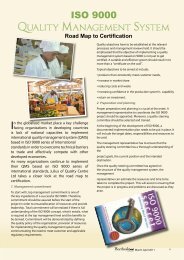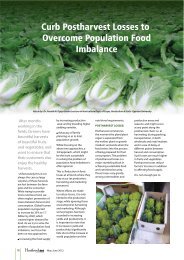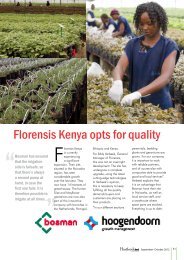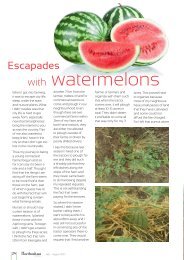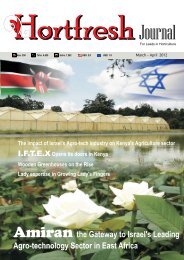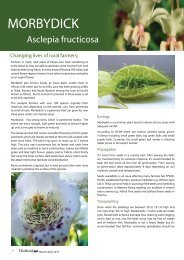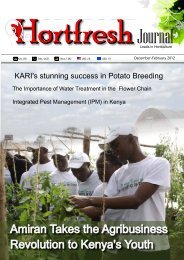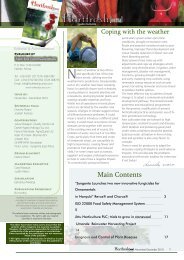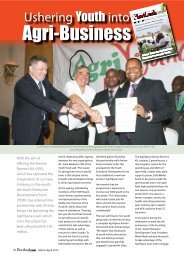Hortifresh Nov__December 2012.indd - Hortfresh Journal
Hortifresh Nov__December 2012.indd - Hortfresh Journal
Hortifresh Nov__December 2012.indd - Hortfresh Journal
- No tags were found...
Create successful ePaper yourself
Turn your PDF publications into a flip-book with our unique Google optimized e-Paper software.
matter. The best pH level forbeans is 6.5 – 7.5. Suitablesoil types range from lightto moderately heavy and topeaty soils with near-neutralpH and good drainage. Frenchbean is susceptible to salinity.EcologyFrench bean is a quantitativeshort-day plant. For everygenotype, there is anoptimum for photoperiodand temperature where thatgenotype will flower after thesmallest possible time intervalfrom emergence. Deviationsin either temperature orphotoperiod cause delaysin flowering. Most Frenchbeans are grown within anarrow range of temperatures(17.5-) 20-22.5(-25)°C;in the equatorial tropics,they are found at higheraltitudes (above 1000 m).Temperatures below or abovethe optimum reduce yieldthrough plant mortality (athigh temperatures), reducedphotosynthesis and failure offlowers to produce maturepods (50-70% of openedflowers). French beans aresensitive to night frost.Suitable growing areasThey include Nairobi, Kiambu,Murang’a, Kirinyaga, Mbere,Meru, and Naivasha.USESFrench bean is used as a pulseand as a green vegetable. Theyoung pods and ripe seedsare eaten and, to a lesserextent, also the green-shelledseeds. In some parts of thetropics, young leaves areused as spinach. In temperateregions, French bean isgrown mainly for the greenimmature pods that are eatenas a vegetable, and are alsocanned and frozen. The driedseeds are also cooked withtomato sauce and canned.Preparation is by boiling;beans are very acceptablewith a wide range of meatand vegetable sauces. Thestraw can be used as forage.AGRONOMIC ASPECTSPropagationand PlantingNormal propagation is by seedbut for special purposes stemcuttings can be rooted easily.Plant population densitiesare 150,000 -200,000plants/ha for dwarf cultivarsand half that for climbingtypes in sole cropping. Inintercropping, densities aremuch lower. Plant distancevaries for bush cultivars insole cropping 30-45 cmbetween the rows and 30 cmin the rows. Wider spacingto 75-90 x 10-15 cm makesweeding easier. For climbingbeans, 4-6 seeds are usuallysown together in hills spaced1 m apart. They may also besown in rows at a spacing of90-120 x 15-30 cm. Depth ofsowing is 3-6 cm. Seed ratedepends on seed size andintended plant populationdensities, up to 120 kg/ha fordwarf beans and 60 kg/hafor climbers in sole cropping.HusbandryFlat cultivation is preferredto ridges. Disturbance ofthe soil should be avoidedbecause damage to the rootsor the collar of the plantencourages diseases. Soshallow tillage is preferredespecially in the period beforeflowering. French bean canbe rain-fed or irrigated.Irrigation is beneficial in semiaridregions, with overheadirrigation preferred overflood irrigation. In peasantfarming, the crop is seldommanured. Crop rotation isnecessary to limit disease.HarvestingSnap beans are harvestedbefore the pods are fullygrown.Harvest starts 6-8weeks after sowing in early cultivars. Pods should be pickedevery 3-4 days, and the number of pickings is greater in climbingcultivars than in bushy ones. The pods are carefully picked andnot pulled from the plants and must have a stalk attached tothem. After picking the pod s are taken to the grading shedimmediately to avoid deterioration of quality. Harvesting duringwet conditions is not recommended, but if unavoidable, the podsshould be placed in a clean cloth to dry them before packing.Handling after HarvestHigh standards of cleanliness should be maintained in handlingharvested French beans. The harvested pods should beplaced in clean plastic containers and covered with a cleandamp cloth to avoid shriveling. The pod is then sorted outto remove broken, malformed, overgrown, off types andinsect-damaged pods. The pods are then taken for packaging,pre-cooling and transported In carefully stacked cartons.Pests and Diseases1. Rust (Uromycesappendiculatus)Disease development favoured by highhumidity. Recognized by the presenceof slightly raised, small, white spotson the lower leaf surface which turnsred to dark brown after a few days.Control: Spray with copper based fungicidesevery 2 weeks at flowering at 50g/20Lt wateror Katerina 720SL at 40ml/20Lt/Ha.2. Angular Leaf Spot (Phaeoisariopsis griseola)Characterized by necrotic and well definedlesions with a typical angular shape. Lesionsmay increase in size, coalesce and cause partialnecrosis and yellowing of leaves, which may<strong>Nov</strong>ember - <strong>December</strong> 2012For leads in Horticulture25



